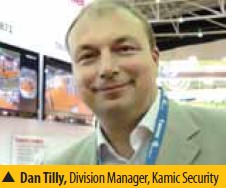When many of the world's security products are manufactured in Asia, shipping times can take a long time. How can the “ship back to Asia” service model be improved? “I find the distance between us and Asian manufacturers difficult,” said Abdel Kadir of Librarie Alibchad. “Shipping products takes a long time. If you need a product urgently, then it needs to be shipped by air, which is expensive. We cannot change the distance, but perhaps if they provide us with spare parts, we can fix the problems ourselves.”
AFTER-SALES SERVICE
When many of the world's security products are manufactured in Asia, shipping times can take a long time. How can the “ship back to Asia” service model be improved? “I find the distance between us and Asian manufacturers difficult,” said Abdel Kadir of Librarie Alibchad. “Shipping products takes a long time. If you need a product urgently, then it needs to be shipped by air, which is expensive. We cannot change the distance, but perhaps if they provide us with spare parts, we can fix the problems ourselves.”
“I think there should also be better after-sales support, because in security, there's no downtime. We have our own service stations around India,” said Kadam. “Rather than shipping to Taiwan, for example, you can give spares to distributors and service providers. Companies that do not have service stations can team up with someone who already has a service network.
“Shipping back warranty products is costly, and as a distributor, part of the cost is taken on by us,” said Tilly, Kamic Group. “We think that it would be a good idea to work with couriers like Fedex, DHL.”
MEETING CUSTOMER NEEDS
Many visitors at Secutech mentioned that manufacturers need to take the end user into consideration more when making their products. Customers in different regions have different needs, and manufacturers might do well to learn what these different needs are. “There needs to be a strategy tie up every time a product goes to a local market, it takes time to make the product fit the needs of that market,” said Behl. “We expect support from partners. For less explored markets, there are always surprises, always geographical and cultural issues. People like to say that the Indian market is like this or that market, but each market is unique.” 
Distributors are closer to the end user and may provide valuable information about what their customers want. “We think that manufacturers should ask us before starting to develop their products,” said Tilly. “Input from the sales field could be useful for R&D. We could provide them with a list of demands from the field. This is similar to software development in the 90s. At that time, the sales force went into the field to figure out what people wanted, and they were able to create a perfect product for the next generation. They are already creating good products, but with slight adjustments with input, these products will fit our customers' needs even better.”
An improved method may be to visit the customer on location. "The best strategy is for them to visit us directly, and we will take them to meet the customer. They can identify with where and how their product is specifically being used in the market," says Peter Simmons, Director of Marketing, Seon Design. "Manufacturers often design equipment on the bench, but the engineering room is different from reality. You need to be out in the field first to truly understand how to design a product."
Are the products easy to use? "When I am presented with a new product to test, I ensure that it is convenient to use before we sell it," said Simmons of Seon. "For example, when testing a camera. I mount and install it myself. I make certain that it is easy to adjust the settings, especially because I have larger hands, and our customers and installers may as well. For all of our products, I go out in the field and see how they should be designed correctly for installation efficiency and ease of use for the customer."
Listening can help manufacturers distinguish themselves from other manufacturers. "We deliver the best products and services by bringing product knowledge to the table," says Simmons of Seon. "At the same time, we want vendors to be more creative and to understand the final customer's requirements. Vendors can separate themselves from their competitors that way."
ESTABLISHING LONG-TERM PARTNERSHIPS
Many distributors and buyers are on the lookout for long term partnerships. But some manufacturers are jeopardizing their chances by sending out unreliable products. One of the challenges is getting a reliable product. We test our products, and sometimes we find problems should have caught before products are pushed out the door,” said Simmons of Seon. “If I had a good experience with them then, I will continue to work with them.”
Another philosophy difference is trying to push economies of scale from the outset. “Everytime you ask price, they want quantity,” said Berio. “Let's start step by step. If I buy a large shipment of product, it may take me a year to sell the product. By that time, I may have found another supplier that is cheaper. Sell me product that I can move in 3 months and 6 months. We can test out the partnership, and if it works well, then we will continue to work in the future. I'm not searching for a spot distributor; I'm searching for a long term relationship. If you build a good relationship, you won't lose customers. You will only lose customers if you are not fair.”
“Somebody must test first,” said Berio, “and it's a mutual investment.”
Clear communication is important. Sometimes this is difficult with cultural language barriers, but other times, it is more about being honest and forthright. “When there's a problem, they say that we're not familiar with what you're talking, nobody's complained about it, we've never heard of this before, but if you install this firmware, it fixes the problem,” said Malkin. “If there's an issue, sometimes it's difficult to get to point where they admit there's a problem.”
Whether it is manufacturers, distributors, SI's or end users, understanding the needs and perspectives of others will help business go a long way.